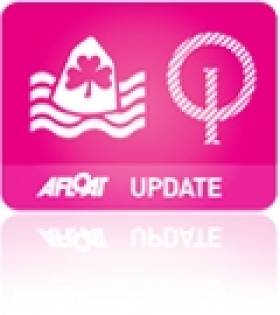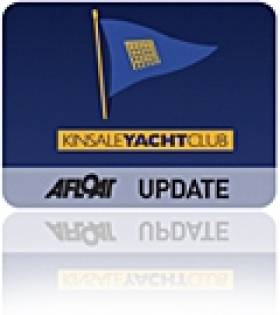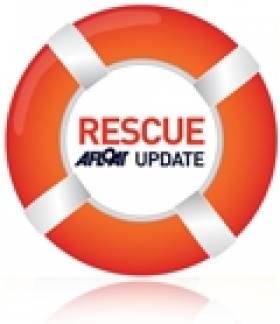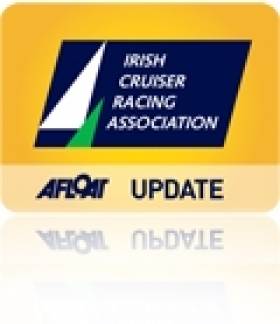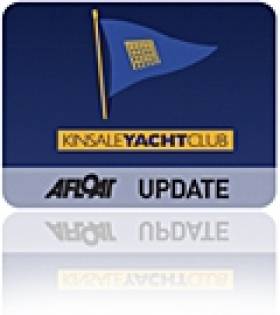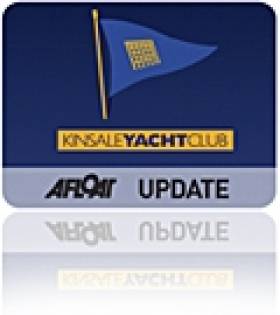Displaying items by tag: Kinsale
Sailing to Success at Kinsale Optimist Trials
Fourteen year old Dun Laoghaire sailor Sean Donnelly was in top form sailing off Kinsale yesterday (SCROLL down for Photos by Bob Bateman) to win four of eight races in the first leg of the 2011 Optimist dinghy sailing trials. All races were completed to schedule. Top ten results below from IODAI.
| 1 | 1438 | Senior | Sean Donnelly | M | 14 | NYC | 10 | 1 | 2 | 2 | 1 | 1 | 2 | 1 | 6 |
| 2 | 1368 | Senior | Sophie Browne | F | 14 | TBSC/RCYC | 22.71 | 5 | 7 | 1 | 4 | 4 | 1 | 3.71 | 4 |
| 3 | 1440 | Senior | Harry Whitaker | M | 14 | RCYC | 31 | 2 | 1 | 13 | 2 | 2 | 7 | 4 | 15 |
| 4 | 1441 | Senior | Eoin Lyden | M | 14 | RCYC/BSC | 44.29 | 10 | 8 | 5 | 6 | 14 | 3 | 7.29 | 5 |
| 5 | 1439 | Senior | Peter McCann | M | 14 | RCYC | 48 | 3 | 3 | 9 | 5 | 10 | 12 | 6 | 12 |
| 6 | 1442 | Senior | Cliodhna Ni Shuilleabhain | F | 13 | KYC | 56 | 4 | 10 | 10 | 17 | 17 | 5 | 8 | 2 |
| 7 | 1433 | Senior | Jil McGinley | F | 14 | RCYC | 59 | 8 | 11 | 8 | 9 | 19 | 4 | 11 | 8 |
| 8 | 1411 | Junior | Ronan Cournane | M | 12 | RCYC/KYC | 64 | 7 | 12 | 4 | 15 | 12 | 20 | 3 | 11 |
| 9 | 1315 | Senior | Fergus Flood | M | 13 | HYC | 68 | 9 | 48 | 18 | 10 | 18 | 8 | 2 | 3 |
| 10 | 1437 | Senior | Sean WADDILOVE | M | 14 | SSC/HYC | 85 |
Sunny Sailing off Kinsale (Photos here!)
Glorious sailing conditions prevailed for the second day of the Kinsale Cruiser Spring Series yesterday writes Claire Bateman. Scroll down for Bob Bateman's sailing photos of yesterday's cruiser action. The only sailing factor missing was the wind! However but after a wait of two and a half hours, the breeze filled in from the south- west giving some 15 knots and enabling racing to commence. Classes 0, 1 and 2 sailed the round the cans course, Classes 3 and 4 were on the windward leeward course and the White Sail Fleet sailed in the harbour. To add to the spectacle the Optimist dinghies in large numbers were sailing further east in trials for international competition.
Kinsale Coast Guard in Daring Cliff Rescue
The Irish Coast Guard's Kinsale unit was involved in the dramatic rescue of a man clinging to the sheer side of a cliff on Sunday.
TheJournal.ie reports that the man, a 20-something English tourist, had been caught on the beach below at high tide and tried to climb the cliff face to escape, but got into difficulty half-way up.
The man was spotted by a couple walking the clifftop near Garrettstown Beach, who alerted the Old Head of Kinsale coastguard unit.
A cliff rescue expert abseiled down to attach a lifeline and harness, and the man was lifted to safety. He was treated at the scene for cuts and bruises.
Unit officer in charge Eddie Butler told the Irish Examiner that the man didn’t know how he had held on as long he did.
"When we arrived and saw the situation, I didn’t think we’d save him. I think we got to him just in time," said Butler. "The water was raging beneath him. If he had lost his grip and fell in, he would have been lost."
Elsewhere, six people were rescued from a sinking cruiser in the River Shannon on Sunday afternoon following its collision with a bridge in Killaloe, Co Clare.
According to The Irish Times, two members of the Irish Coast Guard's Killaloe unit arrived quickly on scene two help the six occupants and their dog to safety on the riverside.
The Killaloe unit reports that the cruiser was subsequently run aground in the shallows at Ballyvalley to prevent its sinking.
Cruiser Racers Head for Royal Cork
Simon McGibney of WIORA confirmed there are already at least 15 boats interested in travelling to the event to join with the Cork, Kinsale and East coast boats. There is also the tantalising prospect of the fleet being joined by no less than ten quarter tonners from the UK who also plan to sail in the Sovereign's Cup at Kinsale the following week. Most of these British boats are crewed by professionals and will race with the Irish Class three fleet. They will, however, be scored separately and will receive a separate trophy.
Sailing with the Quarter Ton fleet will be Anchor Challenge, beautifully restored and modified by former owner Peter Morton, and now in the ownership of Eamon Rohan. At the weekend our spy spotted an all white gleaming boat wending its way up the Kinsale Road and wondered could this possibly have been Anchor Challenge and, if so, will we see a battle between the all black Tiger and the all white newcomer??
For the duration of the ICRA National Championships there will be subsidised launching at Ringaskiddy for all trailerable boats. In addition a very attractive accommodation package has been arranged for all ICRA competitors at the Carrigaline Court Hotel. They are offering three nights B/B plus one evening dinner from Thursday to Saturday and free B/B for Sunday night at €129 per person sharing.
A crew list has been set up by RCYC for skippers wishing to acquire crews with local knowledge and Race Officers for the event will be the hugely experienced Peter Crowley and Richard Leonard.
ICRA Commodore Barry Rose was delighted to inform the meeting that Yacht Designer Mark Mills has joined the ICRA committee where his expertise and wide knowledge will be greatly appreciated. Mark gave a most interesting report on recent developments re racing matters. One item referred to the fact that boats with bulb keels will now be more severely rated and another item of interest is discussion going on with regard to changing the rating bands for the 2012 Commodores Cup. It is believed there is a move afoot to lower the bands i.e. the current middle rated boat may be the big boat for the 2012 event.
Boats to be Sold in Cork Liquidation Sale
Fancy a pre-season boat bargain? It may well be on offer later this month at a 'liquidation sale of boats' due to take place in County Cork with a selection of unused and used power boats. The sale is by order of Mr. Barry Donohue, KPMG, Liquidator, HM Yachts Ltd (In Voluntary Liquidation).
The boats on offer include three unused Jeanneau motoboats inlcuding the popular Merry Fisher Legend. The vessel comes with Suzuki 50HP Four Stroke Engine and road trailer, ready for the season!
The sale will take place at 12 noon on Tuesday 29 March 2011. Viewing is from 10am - 4pm Monday 28 March 2011 or by appointment. The sale takes place at the Michael Murphy Yard, Mission Hill, Kinsale, Co. Cork. (Across from Bandon Co-Op)

For sale: The Merry Fisher Legenda 585 Motor Boat
There are ten lots (including a van) but for the boats for sale include:
Unused Jeanneau Cap Camarat 715wa Motor Boat with a Hallmark Double Axle Trailer with Winch and Rollers, White / Blue.
Unused Jeanneau Cap Camarat 515 Style Motor Boat with a Suzuki 50HP Four Stroke Engine, Model DF50, Plus a Hallmark Single Axle Trailer with Winch and Rollers, White / Beige.
Unused Jeanneau Merry Fisher Legenda 585 Motor Boat with Enclosed Cabin with an Indspension Roller Coaster Single Axel Trailer with Winch and Rollers, White / Blue.
2006 Maxum 2400 SC3 26ft Motor Boat with 300Hp Petrol Inboard Engine with Double Axle Trailer, White / Blue.
2005 O'Sullivans Marine 710 23ft Fishing Boat with Cabin, Yanmar 27hp Diesel Inboard Engine, White / Blue, Name Mary-Linda.
For further details, please contact E-Auctions T: +353 45 883 554. More HERE.
Sailing Body Elects First Female President
In one of her last official functions as Minister for Sport, outgoing local TD Mary Hanafin attended the Irish Sailing Association's annual Ball last Saturday in the Royal Marine Hotel in Dun Laoghaire.
Attended by 315 people the black tie ball featured an awards ceremony that has been hailed 'a great success' by the association.
On Saturday afternoon the association elected a new President, Niamh McCutcheon, the first female ISA President since the organisation was founded in 1945.
A collection in aid of the RNLI raised over €2,250.
Award details below:
ISA Sailing Achievement of the Year
This award is presented by the ISA to recognise the outstanding achievement in a sailing craft by an Irish person or in Ireland during 2010.
Winner: Nicholas 'Nin' O'Leary, Royal Cork Yacht Club
Nicholas' achievements included narrowly beating his father Anthony at the ISA All Ireland Championships in 2010 by just a single point after a nail-biting finale in difficult conditions off Kinsale in November. The win made it three-in-a-row for this remarkable young 24 year old sailor - the only person to achieve this in the 64 years of the event's history.
ISA Volunteer of the Year
This award is given to a member of an ISA affiliated club or class who has made a significant voluntary contribution to their sport during 2010.
Winner: Brian Craig, Royal St. George Yacht Club.
Brian has been nominated by the Royal St. George Yacht Club for the vital role he has played in developing sailing in Ireland and specifically Dun Laoghaire over the past 40 years. His most recent success was winning the bid for Dun Laoghaire to host the 2012 ISAF Youth Worlds.
ISA Youth Sailor of the Year
This award is presented by the ISA to recognise the outstanding achievement by a sailor competing in ISA Performance Pathway boats during 2010.
Winner: Finn Lynch, Blessington Sailing Club
Placing 2nd overall at the Topper World Championships in 2010 left the Carlow sailor in good stead for a Youth Sailor nomination. A determined sailor and strong character, it's clear that with these strengths Finn has the potential to go far in our sport.
ISA Instructor of the Year
This award recognises the role instructors have in providing access to our sports. The final 5 have been nominated by their students with the ultimate winner selected by an ISA judging panel.
Winner: Aine Carroll, Rush Sailing Club
Aine has been an ISA instructor for the last 11 years, instructing both adult and junior sailors in Rush Sailing Club. A keen Mermaid sailor, her love of sailing, her enthusiasm for the sport and willingness to give her time to her sailors have been infectious and remarkable. Apparently the kids at the club think she is a 'legend' and 'cool'!
ISA Training Centre of the Year
The face of ISA water sports to thousands of participants. The best in 2010 as nominated by their students.
Winner: University of Limerick Activity Centre
Situated on the sheltered shores of Lough Derg, University of Limerick Activity Centre has been in operation for over a decade. ULAC provides a varied programme of adventure activities to the general public. The University of Limerick Activity Centre runs ISA courses in sailing dinghies, windsurfers, powerboat as well as emergency care training courses.
Thirty Enjoy Kinsale's Frostbite Finale
Conditions for the final day of the ASM-Marine Frostbite League at Kinsale Yacht Club on Sunday could not have been a more inviting finale for the thirty plus sailors competing in the Laser, Squib and Mixed Dinghy Fleets. Despite losing two of the six week series due to the weather, the last day of the season brought welcome sunshine accompanied by a fresh Force 4 North to North-Westerly breeze, gusting Force 5 at times. Three windward-leeward races were completed which brought the total race number to eleven, with two discards applying. The constantly shifting Northerly breeze, which tracked slowly westwards was the predominate feature in all three races, with an ebb tide having effect to the right hand side of the coarse.
Dara O'Shea (KYC) with another gritty performance in the Laser 4.7 fleet, managed this week to overhaul the league leader Cian Byrne (KYC/RCYC). Leaving it to the final race and with both sailors on nineteen points, Dara grasped the top spot as he fought off his rivals and eventually took line honours and the Laser 4.7 League title. Cian untypically finished fourth but nevertheless secured second place overall, just two points behind. Darragh O'Sullivan had an excellent day's racing with a win and two seconds which pulled him into third place overall, just ahead of Conor Murphy (KYC) who finished on the same points total but one place behind in the final race.
Proving once again that consistency is the key to success in the Frostbite League, Eoghan Cudmore (KYC) with a fifth, third and a second in the Radial Fleet managed to hold off the challenge for the top spot from last year's winner Sean Murphy (KYC) who scored two thirds and a fourth. With the second best results of the day, Colm O'Regan (KYC) scoring two seconds and a fourth, moved up to third place overall. Despite an excellent run of results with three wins on the final day Thomas Chaix (KYC) with insufficient points accrued could not make an impact on the final order.
In the Laser Standard Class Rob Howe (RCYC) continued his outstanding form with a further second place and two firsts bringing his overall total to an unassailable eleven points, fourteen points ahead of his nearest rival Paul O'Sullivan of Monkstown. Scoring two thirds and a second, O'Sullivan's consistent form paid off bringing him into second place overall. David Kenefick (RCYC) who had closely pursued the leader throughout the series, dropped to third place overall as he did not compete on the day.
Seldom conceding line honours Marcus Hutchinson and Ben Fusco (KYC) in the Squib Class went into the final day leading comfortably by eight points. Two wins later and a final second easily secured the league title and are now the new holders of the Bruce Mathews Squib Trophy. In a repeat of last year Paul McCarthy (KYC) finished strongly with two seconds and a win in the final race. These results elevated him from fourth place overall into the prize winning second position. Victor Fusco and Ruth Ennis (KYC) with a final third, fourth and seventh subsequently slipped one place to claim the third prize overall.
In the Mixed Dinghy Class, despite conceding line honours in all three races Brian Jones and Gary Frost (MBSC) in their International 505 finished the series as the lead boat four points comfortably ahead. The RS Feva of David Marshall and Rob Scandrett (RCYC) closed on a high note as they took advantage with three win ASM-Marine KYC Frostbite League - Sunday 27th Feb, 2011.
Conditions for the final day of the ASM-Marine Frostbite League at Kinsale Yacht Club on Sunday could not have been a more inviting finale for the thirty plus sailors competing in the Laser, Squib and Mixed Dinghy Fleets. Despite losing two of the six week series due to the weather, the last day of the season brought welcome sunshine accompanied by a fresh Force 4 North to North-Westerly breeze, gusting Force 5 at times. Three windward-leeward races were completed which brought the total race number to eleven, with two discards applying. The constantly shifting Northerly breeze, which tracked slowly westwards was the predominate feature in all three races, with an ebb tide having effect to the right hand side of the coarse.
Dara O'Shea (KYC) with another gritty performance in the Laser 4.7 fleet, managed this week to overhaul the league leader Cian Byrne (KYC/RCYC). Leaving it to the final race and with both sailors on nineteen points, Dara grasped the top spot as he fought off his rivals and eventually took line honours and the Laser 4.7 League title. Cian untypically finished fourth but nevertheless secured second place overall, just two points behind. Darragh O'Sullivan had an excellent day's racing with a win and two seconds which pulled him into third place overall, just ahead of Conor Murphy (KYC) who finished on the same points total but one place behind in the final race.
Proving once again that consistency is the key to success in the Frostbite League, Eoghan Cudmore (KYC) with a fifth, third and a second in the Radial Fleet managed to hold off the challenge for the top spot from last year's winner Sean Murphy (KYC) who scored two thirds and a fourth. With the second best results of the day, Colm O'Regan (KYC) scoring two seconds and a fourth, moved up to third place overall. Despite an excellent run of results with three wins on the final day Thomas Chaix (KYC) with insufficient points accrued could not make an impact on the final order.
In the Laser Standard Class Rob Howe (RCYC) continued his outstanding form with a further second place and two firsts bringing his overall total to an unassailable eleven points, fourteen points ahead of his nearest rival Paul O'Sullivan of Monkstown. Scoring two thirds and a second, O'Sullivan's consistent form paid off bringing him into second place overall. David Kenefick (RCYC) who had closely pursued the leader throughout the series, dropped to third place overall as he did not compete on the day.
Seldom conceding line honours Marcus Hutchinson and Ben Fusco (KYC) in the Squib Class went into the final day leading comfortably by eight points. Two wins later and a final second easily secured the league title and are now the new holders of the Bruce Mathews Squib Trophy. In a repeat of last year Paul McCarthy (KYC) finished strongly with two seconds and a win in the final race. These results elevated him from fourth place overall into the prize winning second position. Victor Fusco and Ruth Ennis (KYC) with a final third, fourth and seventh subsequently slipped one place to claim the third prize overall.
In the Mixed Dinghy Class, despite conceding line honours in all three races Brian Jones and Gary Frost (MBSC) in their International 505 finished the series as the lead boat four points comfortably ahead. The RS Feva of David Marshall and Rob Scandrett (RCYC) closed on a high note as they took advantage with three wins and claimed the second prize overall. Finishing third on the day and third overall in the series was the Feva of Fiona Lynch and Sofie Kelleher.
At the Prize Giving, Alice Kingston KYC Commodore, congratulated the deserving winners and thanked all the sailors for their efforts. Special thanks went to PRO Bruce Mathews for his dedicated support, the Organisers, the Sponsor ASM-Marine and all those who had helped both on and off the water to make this annual event such a success. Cameron Good KYC Vice-Commodore presented the prizes and June Matthews presented the Bruce Matthews Trophies for the best performances in the Laser Radial and Squib Classes won by Eoghan Cudmore and Marcus Hutchinson respectively. The inaugural Laser 4.7 'Destiny' Trophy was presented to Dara O'Shea.
- ASMMarine
- Kinsale
- yacht
- Club
- Frostbite
- Dara O'Shea
- Cian Byrne
- Darragh O'Sullivan
- Conor Murphy
- Eoghan Cudmore
- Colm O'Regan
- Sean Murphy
- Ben Fusco
- Marcus Hutchinson
- squib
- Paul McCarthy
- Ennis
- Ruth
- Dinghy
- Cameron Good
- Ruth Ennis
- Fiona Lynch
- Sofie Kelleher
- David Marshall
- Laser
- David Kenefick
- RCYC
- Royal Cork
Strong Winds for Kinsale League
With the Laser Fleets not launching until the last minute, they however mistimed the 11.55 First Gun. After a short postponement, the Squib Class who had been reveling in the pre-start conditions was the first fleet to compete. The strong winds persisted throughout the first race with each squall prompting a flurry of capsizing Lasers as one Squib got into difficulties against the lee shore at Jarley's Cove. As the winds moderated to a force five, with the slackening tide and a calmer sea the remaining two races enjoyed easier if still challenging conditions. The decision to combine the three Laser fleets into one start, and the Squibs with the Mixed Dinghies led to the better management of the last two races given the conditions.
The previously unassailable form of Marcus Hutchinson (KYC) helming 'Sensation', was put under greater pressure in the Squib Fleet, with Victor Fusco and crew James Bendon (KYC) on Gemini notably claiming a first place in the second race. However with his crew Ben Fusco, Marcus took line honours in the other two races bringing his total of wins to five out of a possible six; as two discards now apply. Realistically, with next Sunday being the final day of racing and with eight points behind the leader, Gemini will be hoping to secure the second place overall. With a second in the first race adding to his overall score, he is now just two points ahead of the consistent Colm Dunne and Mark Buckley (KYC) who have moved up a place aided by an excellent second in the third race. Having an unsuccessful day due to a sixth in the first race and not completing the last two, Paul McCarthy (KYC) in Mack drops two places to a fourth overall. On only one point adrift he is still very much in contention for a top three placing.
In the Laser Standard Class Rob Howe (RCYC), though obviously comfortable in the strong breeze, did not quite repeat last week's clean sweep of wins. Nevertheless, with one second and two firsts he retains his overall position in the fleet on seven points overall. David Kenefick (RCYC) took advantage by winning the first race, and his subsequent two seconds puts him on just two points behind the leader going into the final day next Sunday. Having now discarded his worst two scores due to missing the first race day, Paul O' Sullivan (RCYC) continued his consistent form with a further three thirds, and is now in third place overall.
Eoin Keller (LDYC), the previous clear leader in the Laser Radial Class and unable to compete this week, slips dramatically from a total of four points to fifteen points and into second place overall. Eoghan Cudmore (KYC) with a splendid second and two wins on Sunday leaps from third into first place overall. Sean Murphy (KYC) who scored a third and two seconds positions himself just one point behind Keller. With very little between the top three, it will take the remaining races to decide final outcome.
Due to other sailing commitments for the young Laser 4.7 fleet, there has been much changing in the league position over the past few weeks; apart from Cian Byrne (KYC/RCYC) who has resolutely held onto the top position from day one. A close and exciting tussle has finally emerged between Cian and Dara O'Shea (KYC), who despite being on the wrong side of a protest decision in the first race, recovered well to gain a subsequent second and first. He has given himself a chance being well positioned just three points behind overall. Conor Murphy (KYC) with an excellent day's achievement of a first and two seconds has shot up the league table into third place overall.
Brian Jones and Gary Frost (MBSC) in their 505 continued unchallenged with a further three bullets in the Mixed Dinghy Class, with the Fevas of David Marshall/Rob Scandrett and Fiona Lynch/Sofie Kelleher in second and third overall.
The ASM Frostbite League at KYC will be completed next Sunday, 27th February 2011. First Gun is at 11.55 a.m.
Kinsale's Ron Holland Expands
New Zealand-born Ron Holland established a reputation for designing exceptionally fast and successful racing yachts during the 1970s, working from his rapidly-expanding studio at Cork in the south of Ireland. Loyal owners soon asked him to design large cruising yachts too – they wanted comfort and style, but they wanted Ron to inject his talent for achieving performance and sea-keeping ability.
By the mid 1980s Ron had designed the world's first 100ft performance superyacht and after that he did not look back. He and his team have created a wide range of sail and power yachts for some of the world's wealthiest, most experienced and discerning clients. They include the 247ft/75m sloop Mirabella, which features the world's tallest single-masted rig; and the award-winning 150ft/46m Transocean Explorer, Marco Polo, which broke new ground with her innovative and energy-efficient propulsion systems.
Ron Holland Design's new Vancouver office is stunningly situated overlooking Coal Harbour and beyond to the snow-capped mountains surrounding Howe Sound. Here, Ron and his team will collaborate with their colleagues in Kinsale, led by Head Designer Rob Doyle, to provide an active and accessible platform for doing business with European, North American and Asia-Pacific clients and their advisers.
Ron Holland Vancouver already has projects in construction, out to yard tender or in advanced stages of design whilst, in the UK, the 150ft/46m custom ketch Christopher has just been launched at Pendennis Shipyard. Immediately following sea trials, Christopher will sail to the Caribbean island of St Barths where Ron Holland will join her enthusiastic owners to compete in the annual St Barth's Bucket. Christopher will be in good company at this special, 25th anniversary, edition of the Bucket Regattas as there will be at least five Ron Holland-designed superyachts also competing. In addition to Christopher, these are Mirabella V, Ethereal, Helios and Charlatan.
Ron Holland Design, Freedom Marine and Platinum Marine look forward to welcoming visitors to the RHD Open House at 100-510 Nicola St., Coal Harbour, Vancouver from 4 – 7pm on March 3rd 2011.
For further information and images, please contact: [email protected]
Marine Department Promised, First America's Cup Capsize, Whales and Sailing Oil Tankers
I am reflecting this week on a varied list of maritime issues which have arisen in my writings on marine topics.
Following recent pieces I wrote about the attitude of political parties in the General Election towards the marine sector, I had a telephone call from a senior Fine Gael politician and, lo and behold, the party included the marine sector in its manifesto, pledging to restore the Department of the Marine, abolished by Fianna Fail. I await post-election developments with interest.
It has been a good week for those interested in protection of whales and dolphins. Hundreds of dolphins were spotted off the Old Head of Kinsale, apparently following shoals of herring and sprat on which they were feeding.
In the Antarctic the Japanese whaling fleet was forced to give in to pressure to stop culling. The Japanese have killed hundreds of whales every year, claiming this was for "scientific purposes," even though it has been identified worldwide as for human consumption. The fleet was ordered home by its Government after increasing international pressure.
The Irish Whale and Dolphin Group published its annual report this week. It was formed in December 1990, dedicated to the "conservation and better understanding" of cetaceans - whales, dolphins and porpoise - in Irish waters through "study, education and interpretation." IWDG turnover in 2010 was around €300,000. It has dealt with up to 10,000 queries a month for information on its website. A total of 92 strandings of 128 individual cetaceans was reported to the IWDG in 2010. This compares to 137 strandings of 169 animals for 2009.
This week oil prices rose because of the unrest in Libya and David Surplus, Chairman of B9 Energy Britain's largest windfarm operator, warned that sooner or later oil will run out. BP is examining the possibility of building a fleet of carbon-neutral, wind-powered sail ships planned, to carry world trade.
On the international sailing scene the new AC 45, forerunner of the next generation of America's Cup boats was launched in New Zealand and had its first capsize. The wing-sailed catamaran is designed for speed and close racing, capable of making up to 30 knots, while intended to be handled in tight, tactical courses. An exciting boat to sail, it will also be very testing of ability. The first capsize of the new boat occurred on Auckland's Hauraki Gulf, hit by what was described as "a freak gust of wind," while the crew were doing maintenance on board before a sailing test.

Back in dock after the capsize
It capsized fully, ending upside down. Three support vessels were needed to pick up the crew and right the boat which was sailed back to its base in Auckland. There was damage to the wing sail, but no injuries to the crew. However, helmets may be an additional precaution needed for sailing these boats, which are to be used in the AC World Series! This will be a circuit of eight regattas for which venue bids are being made at present, with fleet and match racing, to raise the profile of high-performance sailing on worldwide television. Racing is to start in July, with regattas running until May of next year, leading into preparations for the next full AC series in the bigger AC72 catamarans in 2013 in San Francisco.
As the past week showed, there is always something interesting in the sea.
This article is reprinted by permission of the EVENING ECHO newspaper, Cork, where Tom MacSweeney writes maritime columns twice weekly. Evening Echo website: www.eecho.ie


























